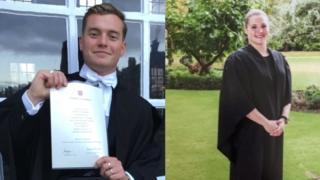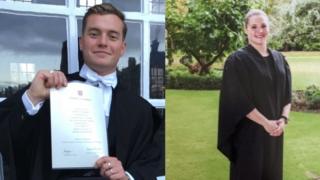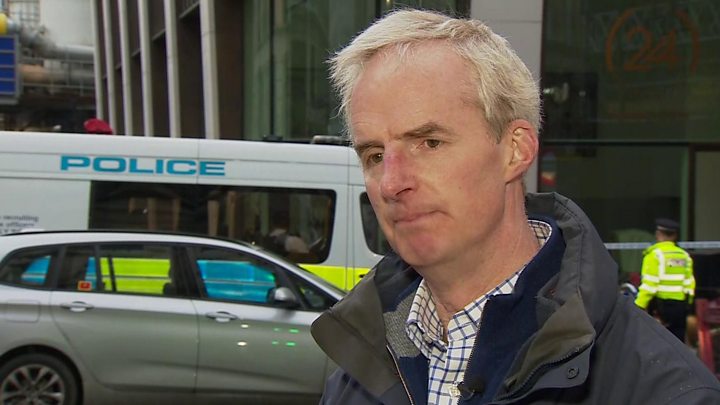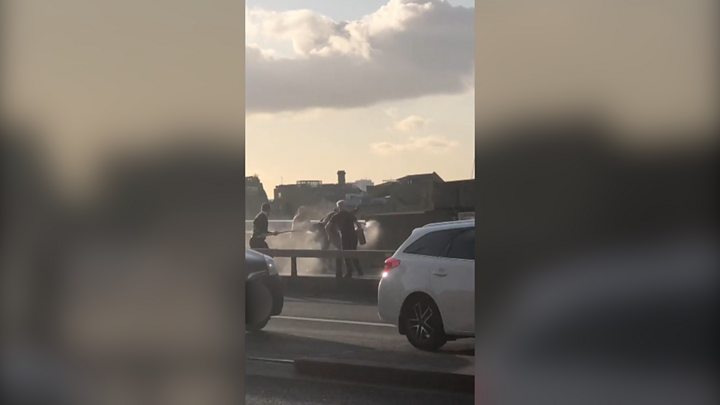London Bridge: Vigil to be held for attack victims
Jack Merritt, 25, and Saskia Jones, 23, will be honoured in a service at Guildhall Yard in the City. …

 Image copyright Met Police
Image copyright Met Police The Mayor of London is among those expected to attend a vigil for the victims of the London Bridge attack in the capital later.
Jack Merritt, 25, and Saskia Jones, 23, will be honoured in a remembrance service at Guildhall Yard in the City.
It will pay tribute to those who were injured, the emergency services and members of the public who responded.
It comes amid an urgent review of the licence conditions of convicted terrorists released from prison.
A book of condolences will be opened at Guildhall Art Gallery, and members of the public will be invited to lay flowers outside nearby Mansion House.
The service will take place at 11:00 GMT, less than a mile from Fishmongers’ Hall, where convicted terrorist Usman Khan, 28, launched his attack on Friday.
Khan, who was released from prison in December 2018 after serving half of his sentence, was later shot dead by police on London Bridge.
Prime Minister Boris Johnson said on Sunday that 74 people jailed for terror offences and released early will have their licence conditions reviewed.
Later that day, Staffordshire Police said a 34-year-old man had been arrested on suspicion of preparation of terrorist acts – but added there was no information to suggest the man was involved in the London Bridge attack.
Mr Merritt and Ms Jones were both University of Cambridge graduates, and had been attending an event for the university’s Learning Together programme – which focuses on prisoner rehabilitation – when they were attacked.
Their families have paid tribute to their loved ones.
Ms Jones’ family said their daughter, from Stratford-upon-Avon in Warwickshire, had a “great passion” for supporting victims of criminal justice.
“Saskia was a funny, kind, positive influence at the centre of many people’s lives,” the family statement read.
“She had a wonderful sense of mischievous fun and was generous to the point of always wanting to see the best in all people.
“She was intent on living life to the full and had a wonderful thirst for knowledge, enabling her to be the best she could be.
“This is an extremely painful time for the family. Saskia will leave a huge void in our lives and we would request that our privacy is fully respected.”
In a statement, Mr Merritt’s family described him as a “talented boy” who “died doing what he loved”.
“Jack lived his principles; he believed in redemption and rehabilitation, not revenge, and he always took the side of the underdog.
“Jack was an intelligent, thoughtful and empathetic person.
“We know Jack would not want this terrible, isolated incident to be used as a pretext by the government for introducing even more draconian sentences on prisoners, or for detaining people in prison for longer than necessary,” the statement read.

Media playback is unsupported on your device
Cambridge University’s vice-chancellor said he was “devastated to learn that among the victims were staff and alumni”.
Prof Stephen J Toope said: “What should have been a joyous opportunity to celebrate the achievements of this unique and socially transformative programme, hosted by our Institute of Criminology, was instead disrupted by an unspeakable criminal act.
“Among the three people injured, whose identities have not been publicly released, is a member of university staff.
“Our university condemns this abhorrent and senseless act of terror.”
Speaking to the BBC, Prof Toope said the fact Mr Merritt was killed by someone he was trying to help “is the greatest tragedy of all”.
“I have profound sadness for the family,” he added.
“This is an attack on our community and it was intended, in such, to produce a form of terror and sadness – and it has clearly done that.”
London Bridge itself was cordoned off for most of the weekend to allow forensic work to be carried out but has now been reopened to traffic.

Media playback is unsupported on your device
Toby Williamson, chief executive of Fishmongers’ Hall, praised the bravery of his staff who intervened to stop the attacker, hailing their actions as “extraordinary things done by ordinary people”.
“There was a scream, there was blood. People thought it was an exercise at first,” Mr Williamson told the BBC.
He recounted how two men, named as Lukasz and Andy, “used fire extinguishers, chairs and narwhal tusks ripped off the wall” to fend off Khan and drive him out of the building.
“They took a decision, one that enough was enough. They were determined it wasn’t going to go on.”
“They are two of the most humble people… but in the heat of the moment, people do extraordinary things.
“I am very proud to know them.”
The vigil at Guildhall Yard follows a service for the victims on Sunday at Southwark Cathedral, which was attended by hundreds.
The Dean of Southwark Cathedral, the Very Reverend Andrew Nunn, said many people were struggling with what happened.
On Friday, the cathedral was put into lockdown as people ran away from London Bridge.
As crowds ran towards the cathedral, the dean recalled having “that sense of déjà vu”, adding that it brought back memories of the nearby attack in Borough Market two years ago, which left eight dead and 48 injured.
Speaking at Sunday’s service, the dean said “memories have been stirred and wounds have been re-opened”.
He added: “What seemed to have been put to the back of people’s minds has now been brought to the fore.
“We have to stand with them. We have to help bear their pain but also speak to that pain with words of hope.”
He also praised the bravery of the people who confronted Khan as he carried out his attack.
“Every event of this nature produces stories of such selfless acts of bravery.”
Dr Vin Diwaker, medical director for the NHS in London, gave an update on the conditions of the three people who were injured in the attack.
He said: “One of the people injured in the London Bridge incident has now been able to return home.
“Two people remain in a stable condition and continue to receive expert care in hospital.”

Media playback is unsupported on your device
Friday’s attack comes after the UK’s terrorism threat level was downgraded on 4 November from “severe” to “substantial”, meaning that attacks were thought to be “likely” rather than “highly likely”.
The terror threat level is reviewed every six months by the Joint Terrorism Analysis Centre, which makes recommendations independent of government.




